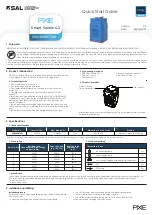
IB01602046E
For more information visit: www.eaton.com
Instruction Booklet
Effective: July 2010
Page
17
2-Position Contactor Based
Non-Automatic Transfer Switch
Section 6: Testing and Problem Solving
6.1 Testing
After the non-automatic transfer switch equipment is initially
installed or during planned outages, the installation should be
tested to ensure that all equipment operates properly. This
attention to detail will help avoid unexpected malfunctions.
Mechanical and/or electrical tests should be performed as
described in this section.
The frequency of subsequent testing should be based on recom-
mendations of the Genset manufacturer.
For manual and non-automatic (electrical) operation of the trans-
fer switch refer to Section 5 in this instruction booklet.
6.2 Problem Solving
A basic problem solving effort is the first step to take prior to
calling for assistance. Frequently, the effort will successfully
address most problems encountered. In addition, several problem
solving procedures are presented here which are specific to the
type of switches or circuit breakers used in this equipment.
If a problem persists after having completed the problem solving
procedure, contact an Eaton representative for further assis-
tance. When calling for assistance, the following is the minimum
information required to properly address the need:
1. General Order Number (GO#) of transfer switch, plus related
Item Number.
2. Catalog and/or Style Number of transfer switch.
3. Actual location of transfer switch (type of facility, address,
etc.).
4. Company name.
5. Name and position of individual representing company.
6. Basic description of situation as it exists.
7. Any results of problem solving steps taken and/or readings
taken.
Section 6.2.1 Transfer Switch Appears Inoperative (Manual
Operation)
Step 1:
Initially verify that there is no voltage on any source
(Source 1 or Source 2) inside the transfer switch.
Step 2:
Attach the handle to the manual lever (see Figure 19)
and rotate the lever down to go to Source 1.
Step 3:
Rotate the lever down again to go to Source 2.
Following above steps, if the transfer switch does not transfer
between two sources, contact factory personnel
Figure 19.Troubleshooting Manual Operation of the Transfer
Switch
WARNING
HIGH VOLTAGES ASSOCIATED WITH OPERATIONAL TRANSFER
SWITCH EQUIPMENT PRESENT A SHOCK HAZARD THAT CAN
CAUSE SEVERE PERSONAL INJURY OR DEATH. USE EXTREME
CAUTION TO AVOID TOUCHING ELECTRICAL CONNECTIONS
WHENEVER INSPECTING OR TESTING THE EQUIPMENT.
IN ADDITION, IMPROPER OPERATION OF THE GENERATOR SET
PRESENTS A HAZARD THAT CAN CAUSE SEVERE PERSONAL
INJURY OR DEATH. OBSERVE ALL SAFETY PRECAUTIONS IN YOUR
GENERATOR SET OPERATIONS AND INSTALLATION MANUALS.
WARNING
HAZARDOUS VOLTAGES IN AND AROUND NON-AUTOMATIC
TRANSFER SWITCH EQUIPMENT DURING THE PROBLEM SOLVING
PROCESS CAN CAUSE SEVERE PERSONAL INJURY AND/OR
DEATH. AVOID CONTACT WITH ANY VOLTAGE SOURCE WHILE
PROBLEM SOLVING.
WARNING
ONLY PROPERLY TRAINED PERSONNEL, FAMILIAR WITH THE NON-
AUTOMATIC TRANSFER SWITCH EQUIPMENT AND ITS ASSOCI-
ATED EQUIPMENT, SHOULD BE PERMITTED TO PERFORM THE
PROBLEM SOLVING FUNCTION. IF AN INDIVIDUAL IS NOT QUALI-
FIED TO PERFORM THE PROBLEM SOLVING FUNCTION, THE INDI-
VIDUAL SHOULD NOT ATTEMPT ANY OF THESE PROCEDURES.








































